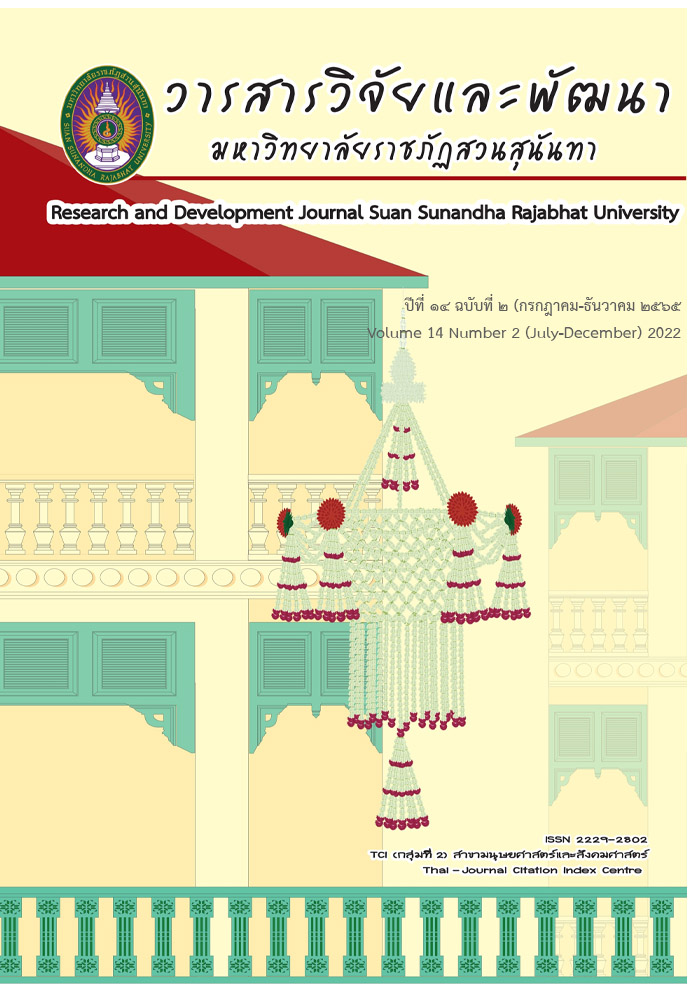การศึกษาคุณภาพการให้บริการผ่านระบบแอปพลิเคชัน“เป๋าตัง”ของประชาชนในเขตพื้นที่อำเภอชัยบาดาล จังหวัดลพบุรี
DOI:
https://doi.org/10.53848/irdssru.v14i2.256051คำสำคัญ:
Service quality, Application" Paotang", Chai Badan Districtบทคัดย่อ
บทความวิจัยนี้มีวัตถุประสงค์ 1) เพื่อศึกษาพฤติกรรมการใช้บริการที่ส่งผลต่อคุณภาพการให้บริการผ่านระบบแอปพลิเคชัน“เป๋าตัง”2) เพื่อศึกษาปัจจัยด้านการรับรู้ความเสี่ยงที่มีความสัมพันธ์กับคุณภาพการให้บริการผ่านระบบแอปพลิเคชัน“เป๋าตัง” และ 3) เพื่อศึกษาคุณภาพการให้บริการผ่านระบบแอปพลิเคชัน“เป๋าตัง” กลุ่มตัวอย่างที่ใช้ศึกษาคือประชาชนในเขตพื้นที่อำเภอชัยบาดาล จังหวัดลพบุรี ซึ่งเป็นผู้ใช้บริการผ่านระบบแอปพลิเคชัน“เป๋าตัง”จํานวน 400 คน เป็นการวิจัยเชิงปริมาณ เครื่องมือที่ใช้ได้แก่ แบบสอบถาม สถิติที่ใช้ในการวิเคราะห์ข้อมูลคือ ค่าเฉลี่ย ร้อยละ ส่วนเบี่ยงเบนมาตรฐาน F-test และการหาค่าสัมประสิทธิ์สหสัมพันธ์แบบเพียร์สัน
ผลการวิจัยพบว่า 1) พฤติกรรมการใช้บริการที่ส่งต่อคุณภาพการให้บริการผ่านระบบแอปพลิเคชัน“เป๋าตัง”ได้แก่ ประเภทธุรกรรมในการใช้บริการ ส่งผลต่อด้านความเป็นรูปธรรม ของการบริการ ด้านความเชื่อถือไว้วางใจ ด้านการให้ความมั่นใจแก่ผู้รับบริการ และจำนวนเงินที่ใช้ในการทำธุรกรรม ส่งผลต่อด้านความเป็นรูปธรรมของการบริการ ด้านความเชื่อถือไว้วางใจ อย่างมีนัยสำคัญทางสถิติที่ระดับ 0.05 2) ปัจจัยด้านการรับรู้ ความเสี่ยงที่มีความสัมพันธ์กับคุณภาพการให้บริการผ่านระบบแอปพลิเคชัน“เป๋าตัง”พบว่า ด้านความเสี่ยงด้านการเงิน ความเสี่ยงด้านประสิทธิภาพ ความเสี่ยงด้านความปลอดภัย ความเสี่ยงด้านสังคม ความเสี่ยงด้านจิตใจ ความเสี่ยงด้านเวลา และความเสี่ยงด้านความเป็นส่วนตัว โดยภาพรวมของทั้ง 7 ปัจจัยมีความสัมพันธ์กับคุณภาพการให้บริการผ่านระบบแอป พลิเคชัน“เป๋าตัง”อยู่ในระดับน้อยที่สุด ทิศทางเดียวกัน อย่างมีนัยสำคัญทางสถิติที่ระดับ 0.05 และ 3) คุณภาพการให้บริการผ่านระบบแอปพลิเคชัน“เป๋าตัง”พบว่า ภาพรวมอยู่ในระดับมาก ได้แก่ ด้านการให้ความมั่นใจแก่ผู้รับบริการ มีค่าเฉลี่ยสูงสุด รองลงมา ด้านความเป็นรูปธรรมของการบริการ ด้านความเชื่อถือไว้วางใจ ด้านการตอบสนองต่อผู้รับบริการ และด้านการรู้จักและเข้าใจผู้รับบริการ ตามลำดับ ข้อเสนอแนะงานวิจัยครั้งนี้ ควรให้ความสำคัญกับการพัฒนาระบบแอปพลิเคชันที่มีรูปแบบการใช้งานที่ง่ายขึ้น เพราะประชาชนส่วนใหญ่มักนิยมใช้บริการผ่านระบบแอปพลิเคชัน“เป๋าตัง”ในสถานที่ตลาดสด ซึ่งการใช้จ่ายซื้อสินค้าต่างๆต้องความรวดเร็ว อีกทั้งผู้ใช้บริการแต่ละคนมีทักษะการรับรู้และเข้าใจในการใช้งานระบบแอปพลิเคชันที่ไม่เหมือนกัน
เอกสารอ้างอิง
At Chai Badan District Office. (2020). Chai Badan District. Retrieved from http://www.lopburi.go.th/amphoe/chaibhadan.htm (In Thai)
Chinukul, K. (2018). Perceived risk and trust affect the intention of conducting financial transactions through Mobile banking for customers of Krung Thai Bank Public Company Limited in Songkhla province. Prince of Songkhla University (In Thai).
Department of Provincial Administration. (2018). Population statistics for the year 2017. Bangkok: Department of Provincial Administration (In Thai).
Electronic Transactions Development Agency. (2019). ETDA reveals that in 2019, Thai people used the internet an average of 10 hours and 22 minutes, and Gen Y was the champion for 5 consecutive years. Retrieved from https://www.etda.or.th/th/NEWS/ETDA-Revealed-Thailand-Internet-User-Behavior-2019.aspx (In Thai)
Kanchanapa, P. (2016). Consumer Behavior. Bangkok: Silpakorn University Press (In Thai).
Krung Thai Bank Public Company Limited. (2021). Pay through QR Code Paotang Krung thai Easy payment in one app KTB. Retrieved from https://krungthai.com/th/personal/detail/201. (In Thai)
Lopburi Provincial Office of the Treasury. (2020). Departments under the Ministry of Finance, Lopburi Province Organize a rights protection team to go to the area to survey the applicant's information for reviewing the right to register for healing 5,000 baht. Retrieved from https://thainews.prd.go.th/th/news (In Thai)
Lueritthi, P. (2017). Electronic Service Quality for User Satisfaction: An Example Case of Mobile wallet applications. Thammasat University (In Thai).
Ministry of Digital Economy and Society. (2019). National policies and plans on digital development for the economy andsociety (B.E. 2018 –2037). Retrieved from https://onde.go.th/assets/portals/1/files/620425-Government%20Gazette.pdf (In Thai)
Mohammad Al Quraish, P. (2020). Technology acceptance,online consumer behavior and perceived risks the relationship to decision to use digital currency of consumers in Bangkok area. Thesis Master of Business Administration Degree Management Program: Faculty of Business Administration for Society Srinakharinwirot University (In Thai).
Phetchut, C. (2018). Application service quality Krung Thai Next Krung Thai Bank, Yala Province. Rangsit University (In Thai).
Rungruengpol, W. (2015). marketing principles textbook (9th ed.). Bangkok: Marketing Move (In Thai).
Secretariat of the House of Representatives. (2021). Summary of Thailand's Measures and Operations in relation to the Coronavirus Outbreak Situation 2019 Between 1 August 2020 – 28 February 2021. Bangkok: Printing House of the Asian and Pacific Parliamentarians' Union. (In Thai).
Sereerat, S. (2007). Consumer behavior. Bangkok: THEERA FILM & SCITEX CO., LTD (In Thai).
Srisaard, B. (2003). Curriculum development and curriculum research. Bangkok: Suwiriyasan (In Thai).
Supthanachotphong, W. (2019). Service Quality Affecting Customer's Repeated Service Intent, Bank of Ayudhya Public Company Limited, Case Study of Central Area, Bangkok, Region 203. Thesis Master of Business Administration Master of Business Administration Program, Plan A, Type A2: Silpakorn University (In Thai).
Thavorntaweewong, S. (2000). Demography. Bangkok: Ramkhamhaeng University Press (In Thai).
Wiphatprechakun, C. (n.d.). A study of the population's wallet application usage behavior in the Bangkok area. Ramkhamhaeng University (In Thai).
Yamane, T. (1973). Statistics: an introductory analysis. New York: Harper & Row.
ดาวน์โหลด
เผยแพร่แล้ว
รูปแบบการอ้างอิง
ฉบับ
ประเภทบทความ
สัญญาอนุญาต
ลิขสิทธิ์ (c) 2022 มหาวิทยาลัยราชภัฏสวนสุนันทา

อนุญาตภายใต้เงื่อนไข Creative Commons Attribution-NonCommercial-NoDerivatives 4.0 International License.
บทความที่ได้รับการตีพิมพ์เป็นลิขสิทธิ์ของ สถาบันวิจัยและพัฒนา มหาวิทยาลัยราชภัฎสวนสุนันทา
ข้อความที่ปรากฏในบทความแต่ละเรื่องในวารสารวิชาการเล่มนี้เป็นความคิดเห็นส่วนตัวของผู้เขียนแต่ละท่านไม่เกี่ยวข้องกับมหาวิทยาลัยราชภัฎสวนสุนันทา และคณาจารย์ท่านอื่นๆในมหาวิทยาลัยฯ แต่อย่างใด ความรับผิดชอบองค์ประกอบทั้งหมดของบทความแต่ละเรื่องเป็นของผู้เขียนแต่ละท่าน หากมีความผิดพลาดใดๆ ผู้เขียนแต่ละท่านจะรับผิดชอบบทความของตนเองแต่ผู้เดียว





